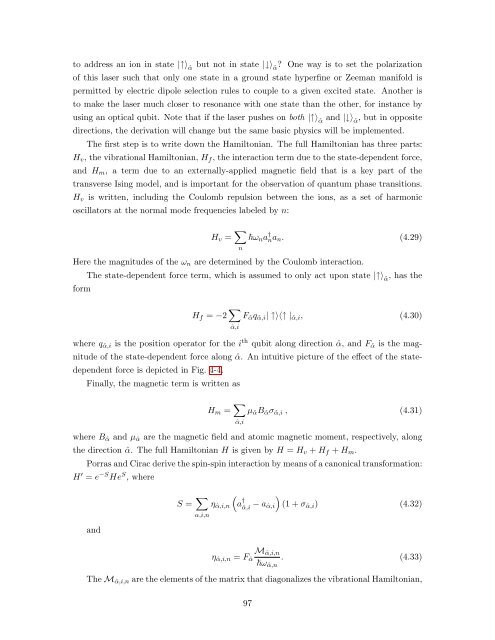Ph.D. Thesis - Physics
Ph.D. Thesis - Physics
Ph.D. Thesis - Physics
Create successful ePaper yourself
Turn your PDF publications into a flip-book with our unique Google optimized e-Paper software.
to address an ion in state |↑〉 ˆα but not in state |↓〉 ˆα ? One way is to set the polarization<br />
of this laser such that only one state in a ground state hyperfine or Zeeman manifold is<br />
permitted by electric dipole selection rules to couple to a given excited state. Another is<br />
to make the laser much closer to resonance with one state than the other, for instance by<br />
using an optical qubit. Note that if the laser pushes on both |↑〉 ˆα and |↓〉 ˆα , but in opposite<br />
directions, the derivation will change but the same basic physics will be implemented.<br />
The first step is to write down the Hamiltonian. The full Hamiltonian has three parts:<br />
Hv, the vibrational Hamiltonian, Hf, the interaction term due to the state-dependent force,<br />
and Hm, a term due to an externally-applied magnetic field that is a key part of the<br />
transverse Ising model, and is important for the observation of quantum phase transitions.<br />
Hv is written, including the Coulomb repulsion between the ions, as a set of harmonic<br />
oscillators at the normal mode frequencies labeled by n:<br />
Hv = <br />
ωna † nan. (4.29)<br />
Here the magnitudes of the ωn are determined by the Coulomb interaction.<br />
form<br />
n<br />
The state-dependent force term, which is assumed to only act upon state |↑〉 ˆα , has the<br />
Hf = −2 <br />
ˆα,i<br />
Fˆαqˆα,i| ↑〉〈↑ |ˆα,i, (4.30)<br />
where qˆα,i is the position operator for the i th qubit along direction ˆα, and Fˆα is the mag-<br />
nitude of the state-dependent force along ˆα. An intuitive picture of the effect of the state-<br />
dependent force is depicted in Fig. 4-4.<br />
Finally, the magnetic term is written as<br />
Hm = <br />
µˆαBˆασˆα,i , (4.31)<br />
ˆα,i<br />
where Bˆα and µˆα are the magnetic field and atomic magnetic moment, respectively, along<br />
the direction ˆα. The full Hamiltonian H is given by H = Hv + Hf + Hm.<br />
Porras and Cirac derive the spin-spin interaction by means of a canonical transformation:<br />
H ′ = e −S He S , where<br />
and<br />
S = <br />
α,i,n<br />
ηˆα,i,n<br />
<br />
a †<br />
<br />
ˆα,i − aˆα,i (1 + σˆα,i) (4.32)<br />
Mˆα,i,n<br />
ηˆα,i,n = Fˆα<br />
ωˆα,n<br />
. (4.33)<br />
The Mˆα,i,n are the elements of the matrix that diagonalizes the vibrational Hamiltonian,<br />
97
















